|
When looking up parts for a D-24T, be aware that the engine is available in a
number of varieties. These include manual or automatic transmission and
California versions. Knowing both the VIN and engine number can help to
determine the correct parts numbers when you buy your parts. |
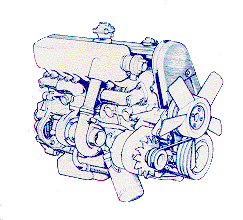
|
B-23OFT
The B-23F-Turbo gasoline engine was replaced in 1985 with a new Turbo engine,
the B230F-Turbo. This new engine is an offshoot of the B-23OF low-friction
engine described in Workbook No. 2. The proven cast-iron block, aluminum
cross-flow cylinder head and overhead camshaft design first introduced with the
B-21 in 1976 was continued.
|
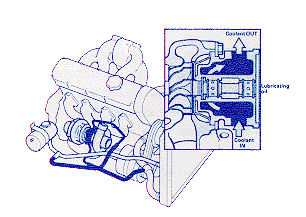
|
All turbochargers fitted on Volvos (both 240 and 700 cars) contain a
center bearing that is force-fed a stream of fresh engine oil to run properly.
Clean oil is crucial to the life of a turbocharger, and that's why oil change
intervals are more frequent for Turbo models. Even with a supply of clean oil,
that bearing gets very hot. Volvo turbochargers are made especially for Volvo
by two companies: Garrett in the United States or Mitsubishi in Japan.
|
Starting with the 1987 models, a water-cooled jacket was added to the
turbochargers to provide even more cooling for the center bearing. If you need
to replace your or service your turbo, installation
kits may be available so that enables the water-cooled Turbos to fit older 700 and
240 Turbo models.
The B-23OF-Turbo contains modern high-performance goodies like an intercooler
and LH fuel injection. An accessory parts kit (Turbo+) adds a 20% horsepower
boost to an already potent engine!
B-280F
Starting with the 1987 760 GLE sedan and station wagons, a new V-6 was
introduced to replace the B-28F. The B-280F provided a smoother idle, better
fuel economy, easier serviceability and improved performance. It is a
wet-liner, all-aluminum, overhead camshaft engine. Although the basic design
was similar to the older engine, many new parts were added.
These new parts include the crankshaft, camshaft, oil system, intake/exhaust valves,
intake manifold, cooling fan, fuel injection system and ignition system.
|

|
The B-280F is a different engine than the B-28F when major engine repair parts
are considered. The new fuel system (LH-Jetronic 2.2) has more in common with
the four cylinder B-23OF and B-23OFT than the older B-28F.
|
By now you must be thinking -- as soon as I learn something, it gets more complicated! Yes, you're right ...
Listed below are descriptions of a few fast-moving 700 parts and locations to remember:
|

|
Timing Belts -- On all engines except the B-280F and B-28F, the overhead
camshaft is driven by a toothed rubber timing belt. This part requires
replacement at regular intervals, as indicated in the owner's manual. The B-28F
and B280F have chains.
|
|
Air Filters -- A flat, pleated-paper air filter is located in a housing in the
engine compartment in all 700 models. Air filter part numbers (as well
as size and shape) vary by each engine type.
Replacement intervals are listed in the Owner's Manual.
|

|
NOTE: Beginning with all 1986 model Volvos, the oil and oil filter change
interval was LOWERED from 7,500 miles/12,500 kilometers to 5,000 miles/8,000
kilometers for all engines. The exact oil and filter change intervals and
conditions appear in the owner's manual.
|

|
Fuel Filters/Fuel Pumps
The fuel filter and fuel pump for the B-230F, B-230FT and B-280F are located
under the middle of the car on a u-shaped bracket (the 240/260 have the pump next
to the gas tank). The filter for the B-28F is located on the left side in the
engine compartment on the firewall, and the pump is under the middle of the car
like the others.
|
Sound easy enough? It gets more complicated!
It's a rare thing these days to see a new car with a mechanical fuel pump
attached to the side of the block (like the pump on B-18 engines described in
Workbook No. 1) or even a single electric fuel pump located next to the gas tank
(like the B-20E or B-20F described in Workbook No. 2). Most new cars have a
combination of pumps.
Generally speaking, all 700s have the following parts in the fuel system
(except diesels):
|
|
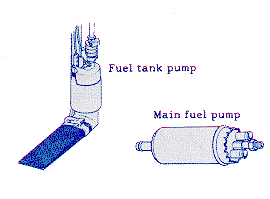
|
A pump INSIDE the gas tank (called a tank pump or pre-pump) that is combined
with the fuel gauge sending unit. This pump/ sending unit
also has a filter on the end, but the filter rarely needs replacement.
|
2. Another fuel pump in the 700s is located OUTSIDE the gas tank under
the middle of the car. Cars equipped with the B-28F engine have a large, round
part called an accumulator on the same bracket next to the fuel pump. The
accumulator is not a fuel filter or fuel pump. All other gas engines have the
fuel filter in this location.
TIP: Make sure when you tell your Volvo technician, "I need a fuel pump
for a late-model Volvo," that you mean the fuel pump OUTSIDE of the gas
tank. |
|
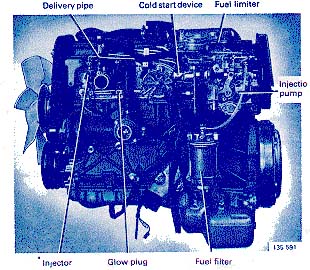
|
The Volvo 700 diesel engines do not have electric pumps. Instead, they
rely on the fuel injection pump on the side of the engine block to suck the fuel
from the tank. (The expression, "that sucker really goes" truly applies to
diesels.)
|
Air Conditioning
A new air conditioning design is installed on the 700 and is available in three
versions:
- A manually controlled heater without air conditioning;
- A manually controlled heater with A/C;
- A climate-control system that combines the A/C functions with the rieating
system and keeps the interior of the car at a selected temperature (called
automatic temperature control).
|
|

|
The ATC system installed on selected 700 car models represents the first time a
system of this type has been made available on a North American Volvo.
In addition to adding refrigerant to the system and replacing the compressor
belt, the following parts might need replacement on high-mileage cars:
- Pressure hoses
- Compressor clutch
- Receiver drier
- Temperature sensors
- Expansion valve
- Fan motor
- Water valve (heater valve)
The cooling system on all engine types has an aluminum water pump to circulate
coolant throughout the engine block, cylinder head and heater core in the A/C
unit.
Volvo hose clamps are designed to be compatible with Volvo hoses. Makes sense,
doesn't it? They have smooth internal surfaces and will not cut the hoses when
tightened. Many aftermarket varieties cut the hoses.
Emission Parts
The combinations of emissions systems and their individual parts described in
Workbook No. 2 (240/260) apply to the 700.
Study the parts pictured below. Relate the picture with the name. You may
realize that a few of these parts that affect emissions also belong to other
parts systems (like fuel, exhaust and ignition). Take your time.
|

|
Not shown are the many sensors, plugs, hoses, gaskets, senders and valves
that make the emission system work correctly.
Electrical
|
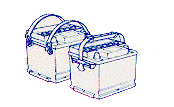
|
A 12-volt lead plate battery was installed on most 1983-87 700s. As a general
rule, four-cylinder cars have a 55 amp-hour rating; six-cylinder gas engine cars
have a 66 amp-hour rating, and the Turbo diesel has a 90 amp hour rating.
|
|
The batteries are maintenance-free and housed in a tray that prevents any acid
from reaching the body. Genuine Volvo replacement batteries are designed and
tested specifically for the 700. It gets very cold in Northern Sweden --
a real test for car batteries. For this reason, genuine Volvo batteries are
the best choice.
|
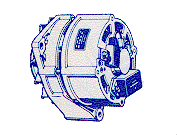
|
The 700 use an alternator with a built-in voltage regulator just like the
later 240. Advances in electronics have reduced the size of the
regulator. Be aware that regulators may appear different in physical size but
perform the same function.
|
Starter motors for all models are available. While most
starters are manufactured by Robert Bosch for Volvo, some Turbo diesels came
equipped with Hitachi starters.
The electrical system on the 700 is designed to handle luxury upmarket
features. These include the features discussed in the 260 (Workbook No.
2), plus new ones:
- Electrically heated outside mirrors.
- Time-delay switches mounted on the instrument panel to control the heated
mirrors and rear window.
- Automatic temperature control.
- Special switches containing indicator lamps.
- Fluid level indicators.
- Courtesy lights in the doors.
- Additional relays located on the fuse block as well as in the engine compartment.
The heart of the electrical system is the central electrical unit. This is
located behind the ashtray in all 1983-87 700s. It is a combination of a fuse
block and relay panel.
|

















